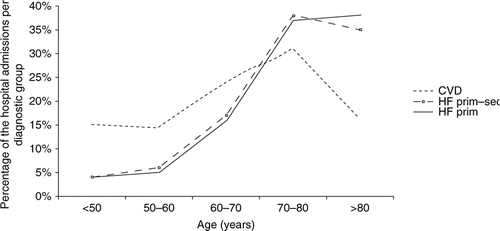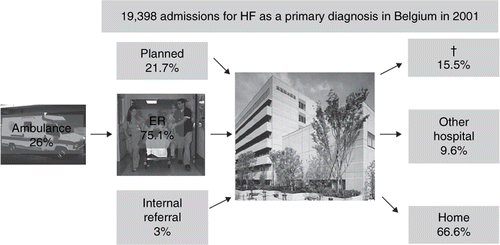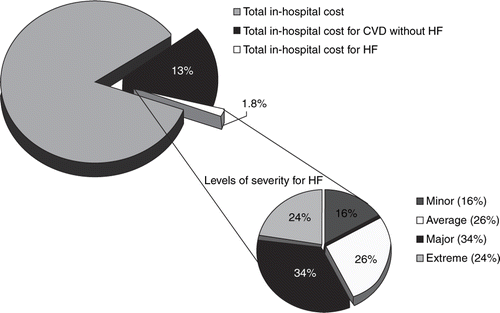Summary
Heart failure (HF) is a serious public health problem worldwide. It has a high prevalence, affects mainly the elderly and causes high mortality or disability with high economic costs. The aim of the present study was to calculate the number of admissions for HF, the total in-hospital stay, the mean length of in-hospital stay and the in-hospital costs due to HF in Belgium.
Retrospective analysis of data from the national hospital registration system provided the following results. In 2001, there were 19,398 admissions with HF as a primary diagnosis, with a total in-hospital stay of 286,938 days. The mean in-hospital stay for HF was 14.8 days. The total in-hospital cost of HF as a primary diagnosis was € 94,113,827, representing 1.8% of the total hospital expenditure.
The limitations of this study are its mere focus on admissions and their characteristics in 2001, and the use of a retrospective analysis. Nevertheless, it led to the conclusion that HF was responsible for a significant number of in-hospital days, with a significant impact on healthcare costs in Belgium.
Introduction
Heart failure (HF) is recognised as a major public health problem and the costs of this chronic disease are significant. HF has a high prevalence, affecting mainly the elderly; more than 15 million people worldwide have HFCitation1. The prevalence of HF in European populations ranges from 0.4 to 2%Citation2. A recent study in The Netherlands demonstrated a higher prevalence in men, increasing with age (from 0.9% in patients aged 55–64 years to 17.4% in patients aged 85 years). The incidence of HF is 14/1,000 person-years and increases with ageCitation3. HF causes high mortality and disability for affected patients, with high economic costs. Approximately 50% of patients with HF die within 4 yearsCitation4, and it contributes 12% to male mortality due to cardiovascular disease (CVD) and 19% to female mortality due to CVDCitation5. Patients with HF have statistically significant impairment of all aspects of quality of life, not simply physical functioningCitation6. The cost of HF as a function of total healthcare costs is 1.1% in The Netherlands, 1.2% in the UK and 1.9% in FranceCitation7. Little is known about the contribution of HF to healthcare costs in Belgium.
The aim of this study was to calculate the number of in-hospital admissions for HF, the total in-hospital stay, the mean length of in-hospital stay, the total in-hospital costs of HF (per severity level) and the contribution of HF to healthcare costs in Belgium in 2001.
Methods
Data collection
Belgian healthcare costs are paid by the social security system, who receive their budget from taxes. Belgian patients are free to consult a general practitioner (GP), a specialist as well as an emergency physician in the hospital. Because this can create high costs, the national hospital registration system was implemented in 1990.
Retrospective analysis of data from the national hospital registration system (MKG) was performed. Data were requested and received from the Ministry of Social Affairs for 2001. This year was selected arbitrarily but can be considered to be representative. Since 1990, registration of the primary and secondary diagnosis for admission and the type of intervention are mandatory for every patient admitted to a hospital in Belgium. The treating physician is responsible for coding using the 9th Revision of the WHO International Classification of Diseases (ICD-9). There are several levels of control on the reliability of the data. The first level of control is carried out by hospital administration and the second level is performed by the Ministry of Social Affairs. Medical inspectors of the Ministry of Social Affairs choose hospitals at random and control the correctness of the registered information by comparing it with the medical file. Nevertheless, the number of admissions is more likely to be an underestimation of actual admissions. The number of hospital admissions and their characteristics (for example, total in-hospital stay, mean length of in-hospital stay, ways of admission and discharge, readmission rate and in-hospital mortality rate) were derived from this database. It is important to note that the readmission rates found in the MKG database for 2001 are actually an underestimation of the real figure because the admissions in the first month of 2001 could have been readmissions with a first admission at the end of 2000. Since 1996, data from the MKG were linked to the financial database of national healthcare (MFG), developed by the social insurance system that pays the medical costs in Belgium (RIZIV). The mean in-hospital cost for HF as a primary diagnosis was derived from this database and used to determine the total in-hospital cost for HF. This database includes costs that are not estimated but truly made by the social insurance system.
Statistics
All hospitalisations in Belgium coded ICD-9 390–459 (CVD) in 2001 were selected from the MKG database. A subanalysis of this database of hospitalisations with HF (ICD-9 codes 428, 428.1 and 428.9) as the primary diagnosis was performed. The choice of HF as a primary diagnosis was made to prevent an overestimation of costs due to, for example, unexpected complications. Data were obtained in ASCII files. Transformation of the data to SPSS was carried out. All data analyses were performed using SPSS for Windows version 10.0.
Cost calculation
The mean in-hospital cost per admission for HF, independent of severity level, was €4,852, which included hospitalisation cost, medical fees and drug therapyCitation8.
The mean in-hospital cost for HF per severity level in 2001 was calculated using all patients refined diagnosis-related groups (APR-DRG) and the linked databases MKG-MFGCitation8,Citation9. HF is divided into four categories of severity: minor; average; major; and extreme. This classification is based on the primary diagnosis, the secondary diagnosis, operating procedures and ageCitation9. The mean in-hospital costs per admission for patients with HF of minor, average, major and extreme severity were € 3,004, € 3,964, € 5,475 and € 9,153, respectivelyCitation8. Next to severity of illness, the APR-DRG system also uses risk of mortality and prognosis in its classificationCitation9.
For the total in-hospital cost per severity level, the number of admissions for HF per severity level were multiplied by the mean in-hospital cost for HF per severity level. A more detailed cost component table, using costs that were not rounded off, is also included.
The contribution of HF to the healthcare costs in Belgium was calculated as a percentage of the in-hospital costs for CVD (€ 868,544,228), the total in-hospital costs (€ 5,256,676,247) and the gross domestic product (€ 254,153,000,000)Citation8,Citation10.
Results
Hospital admissions for cardiovascular disease
There were 279,258 admissions for CVD in Belgium in 2001 (). The mean age of patients admitted to hospital with CVD was 66 years (standard deviation (sd) 16 years). Admissions for CVD had a total in-hospital stay of 2,399,648 days with the mean in-hospital stay being 8.5 days (sd 25 days). There were 35% readmissions within the same year and the mean number of days since last discharge was 3 months (sd 3.2 months). The in-hospital mortality was 5.5%.
Table 1. Characteristics of patient with CVD and HF as a primary diagnosis for hospital admission in Belgium, 2001.
Hospital admissions for heart failure as a primary diagnosis
There were 19,398 admissions with HF as a primary diagnosis in Belgium in 2001 (). The number of admissions for HF of minor, average, major and extreme severity were 4,868, 6,227, 5,761 and 2,542, respectively and the mean age of patients admitted to hospital with HF as a primary diagnosis was 76 years (sd 11.9 years). shows the age distribution for patients admitted to hospital with CVD and HF. The proportion of patients with HF as a primary diagnosis that were admitted to the hospital through the emergency room equalled 14,568 (75.1%), and 3,788 (26%) of these patients were transported by ambulance (). These admissions included 4,209 admissions (21.7%) that were planned in advance and 621 admissions (3.2%) that were internally referred or unknown. Of the 19,398 admissions, 8,926 were referred to the hospital by their GP. Admissions for HF as a primary diagnosis had a total in-hospital stay of 286,938 days, representing 1.3% of the total in-hospital days in Belgium. The mean in-hospital stay was 14.8 days (sd 16.5 days). Some of these patients, 28.8% (n=5,580) were treated in the intensive care unit, with a mean length of stay of 3.8 days (sd 5.4 days). One-half of the patients (50.9%) were readmitted within the same year for HF or other CVDs. The mean time since last discharge was 3.2 months (sd 3 months). Patients were either discharged to a different hospital (9.6%); returned home (66.6%); went to another place (home for the elderly, psychiatric institution, unknown) (8.3%); or died in the hospital (15.5%).
Contribution of heart failure to healthcare costs in Belgium in 2001
The total in-hospital cost for HF as a primary diagnosis was €94,113,827, representing 10.8% of the total in-hospital cost for CVD, 1.8% of the total in-hospital cost for Belgium in 2001 and 0.04% of the gross domestic product (). The total in-hospital costs for patients with HF of minor, average, major and extreme severity were € 14,624,543, € 24,681,337, € 31,541,936 and € 23,266,011, respectively. gives an overview of how these costs are composed. Hospitalisation consumed € 63,421,845 (67.4%) of the total in-hospital costs for HF as a primary diagnosis. Thus, hospitalisation is responsible for 67% of the total in-hospital cost for HF as a primary diagnosis. Other cost components include: pharmaceuticals (5.9%); medical care (14.6%); imaging (9.4%); clinical biology (1.7%); implants and prostheses (0.2%); and other costs (e.g. costs for blood and blood plasma, or costs for human tissue) (0.8%).
Table 2. Disaggregated costs per severity level of heart failure (€).
Discussion
In the present study, a mean length of in-hospital stay for HF of 14.8 days was found. In the literature, the average length of stay for HF varied from 3.95 to 12.9 daysCitation11–14.
The total in-hospital cost per severity level was highest for HF of major severity. HF of extreme severity consumed less of the total in-hospital expenditure for HF owing to a smaller number of admissions. In accordance with the literature, this study showed that the mean in-hospital cost for HF increased in relation to the severity of diseaseCitation15. The severity of illness in the APR-DRG classification is used for hospital management. It is different from the New York Heart Association (NYHA) classification of stages of HF. The latter is a clinical classification used to determine the best therapy. A positive correlation between severity of illness and NYHA severity classes can be expected. The literature notes that patients in NYHA classes III and IV consume 90% of the healthcare resources devoted to chronic heart failure managementCitation16. In this study, 43% were high-risk individuals with HF of major or extreme severity; another study showed a baseline percentage of 56% high-risk individualsCitation17.
Admissions for HF contribute 1.8% to the total in-hospital cost, in accordance with the literature. It can be argued that the range of cost contribution of HF to total healthcare expenditure in industrialised countries is quite large, namely 1–2%Citation18. However, recent studies in the UK and Sweden confirm direct costs of HF to be approximately 2% of the total healthcare expenditure19,20. Differences in this cost contribution are due to different costs that were included. Some of these studies have included the cost of operations such as cardiac transplantation (e.g. the UK study), whereas others have not (e.g. the Dutch study)Citation15. This study did not include the cost of transplantations and was limited because of data entry, which was performed by the treating physician when the patient left, or sometimes after the patient had left the hospital. However, the correctness of the data was controlled on different levels owing to the fact that reimbursement of medical care is linked with these data. Mistakes detected by control are punished by law and this has great financial implications for the hospital.
Hospital cost appears to be the main cost driver of total in-hospital costs for HFCitation7. The present study demonstrates that hospitalisation accounted for 67% of total in-hospital cost for HF as a primary diagnosis in Belgium in 2001. For France, the UK, The Netherlands and Sweden, this percentage was 64, 60, 68 and 74%, respectivelyCitation7. Stewart mentions that the financial burden of HF is likely to rise in all countries that have documented hospitalisations accounting for more than two-thirds of HF expendituresCitation21. This study points out that Belgium is a member of this group of countries.
To reduce the total costs of HF, the cost effectiveness of several HF strategies should be studied. Any intervention that is able to decrease hospital admissions and length of in-hospital stay could trigger significant cost savingsCitation7. Several studies point out different strategies capable of reducing costs. These strategies include: optimisation of drug therapy; multidisciplinary HF management programmes; strategies targeted at high-risk individuals; and evidence-based therapies (e.g. cardiac resynchronisation therapy)Citation15,Citation17,Citation20–24.
Despite mainly positive results of multidisciplinary HF programmes, only a few countries have implemented a large number of these programmes25. In Belgium, <30% of the responding hospitals was found to have a HF programme. Among the leading countries regarding the implementation of HF programmes were Sweden, Norway and The Netherlands28.
The economic burden of HF on healthcare costs in Belgium is significant and will be more extensive in the future owing to an ageing population. New treatments that can reduce the number of in-hospital days for patients with HF will have an important economic impact on the healthcare costs.Acknowledgements
Acknowledgements
Declaration of interest: The authors have declared no conflict of interest and received no payment in the preparation of this manuscript.
Notes
References
- Young JB. The global epidemiology of heart failure. Medical Clinics of North America 2004; 88: 1135–1143
- Cowie MR, Struthers AD, Wood DA, et al. Value of natriuretic peptides in assessment of patients with possible new heart failure in primary care. Lancet 1997; 350: 1349–1353
- Bleumink GS, Knetsch AM, Sturkenboom MC, et al. Quantifying the heart failure epidemic: prevalence, incidence rate, lifetime risk and prognosis of heart failure. The Rotterdam Study. European Heart Journal 2004; 25: 1614–1619
- McMurray J, McDonagh T, Morrison CE, et al. Trends in hospitalization for heart failure in Scotland 1980–1990. European Heart Journal 1993; 14: 1158–1162
- Flemish Agency for Care and Health. Mortality by cardiovascular disease, men and women, 2001–2002. Available at: http://www.wvc.vlaanderen.be/gezondheidsindicatoren/ [accessed 22 November 2006].
- Hobbs FD, Kenkre JE, Roalfe AK, et al. Impact of heart failure and left ventricular systolic dysfunction on quality of life: a cross-sectional study comparing common chronic cardiac and medical disorders and a representative adult population. European Heart Journal 2002; 23: 1867–1876.
- Lee WC, Chavez YE, Baker T, et al. Economic burden of heart failure: a summary of recent literature. Heart & Lung 2004; 33: 362–371
- Ministry of Social Affairs, Safety of Food and Environment. Financial feedback per pathology. Available at: https://tct.fgov.be/etct/anonymous?lang=nl [accessed 22 November 2006].
- Averill RF, Goldfield NI, Muldoon J, et al. A closer look at all-patient refined DRGs. Journal of Amercian Health Information Management Association 2002; 73: 46–50
- National Bank of Belgium, Department of General Statistics. Economic indicators of Belgium. Available at: http://www.nbb.be/doc/DQ/N/dq3/histo/INE1217.pdf [accessed 22 November 2006].
- Ni H, Nauman DJ, Hershberger RE. Analysis of trends in hospitalizations for heart failure. Journal of Cardiac Failure 1999; 5: 79–84
- Philbin EF, Rogers VA, Sheesley KA, et al. The relationship between hospital length of stay and rate of death in heart failure. Heart & Lung 1997; 26: 177–186
- Lowe JM, Candlish PM, Henry DA, et al. Management and outcomes of congestive heart failure: a prospective study of hospitalised patients. Medical Journal of Australia 1998; 168: 115–118
- Tsuyuki RT, Shibata MC, Nilsson C, et al. Contemporary burden of illness of congestive heart failure in Canada. Canadian Journal of Cardiology 2003; 19: 436–438
- Berry C, Murdoch DR, McMurray JJ. Economics of chronic heart failure. European Journal of Heart Failure 2001; 3: 283–291
- Szucs TD. The growing healthcare burden of CHF. Journal of the Renin–Angiotensin–Aldosterone System 2000; 1((Suppl. 1))2–6
- Piepoli MF, Villani GQ, Aschieri D, et al. Multidisciplinary and multisetting team management programme in heart failure patients affects hospitalisation and costing. International Journal of Cardiology 2006; 111: 377–385
- McMurray JJ, Petrie MC, Murdoch DR, et al. Clinical epidemiology of heart failure: public and private health burden. European Heart Journal 1998; 19((Suppl. P))P9–16
- Stewart S, Jenkins A, Buchan S, et al. The current costs of heart failure to the National Health Service in the UK. European Journal of Heart Failure. 2002; 4: 361–371
- Ryden-Bergsten T, Andersson F. The health care costs of heart failure in Sweden. Journal of Internal Medicine 1999; 246: 275–284
- Stewart S. Financial aspects of heart failure programs of care. European Journal of Heart Failure 2005; 7: 423–428
- Tsuyuki RT, Fradette M, Johnson JA, et al. A multicenter disease management program for hospitalized patients with heart failure. Journal of Cardiac Failure 2004; 6: 473–480
- McAlister FA, Stewart S, Ferrua S, et al. Multidisciplinary strategies for the management of heart failure patients at high risk for admission. Journal of the American College of Cardiology 2004; 4: 810–819
- Stewart S, Blue L, Walker A, et al. An economic analysis of specialist heart failure nurse management in the UK: can we afford not to implement it?. European Heart Journal 2002; 23: 1369–1378
- Gregory G, Kimmelstiel C, Perry K, et al. Hospital cost effect of a heart failure disease management program: The Specialized Primary and Networked Care in heart Failure (SPAN-CHF) trial. American Heart Journal 2006; 151: 1013–1039


